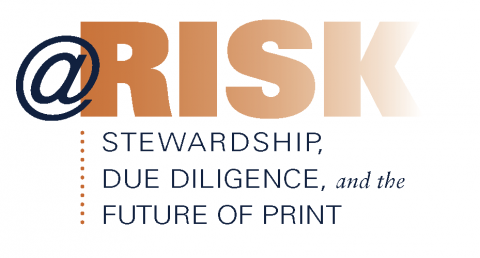April’s @Risk Forum generated a wealth of ideas about where and how CRL should focus its support for the preservation of print collections. The @Risk conversations dwelled less on the economics and mechanics of storage and retention, than on larger issues of institutional stewardship and due diligence. To attendees it was clear what is at stake: the integrity of a vast corpus of recorded knowledge and information built by North American libraries over more than two centuries is now threatened by physical deterioration and new pressures to reduce the footprint of library storage. Deanna Marcum, managing director of ITHAKA S+R, made a compelling case for the urgency of coordinated, decisive action on a national level. As Deanna warned, “We are running out of time.”
The Forum presentations are all available on the event website, and you can read Deanna Marcum’s remarks on her blog at ITHAKA. In the present post, and in a series of subsequent posts, I will report on five big ideas generated by the @Risk discussions that are now shaping CRL's agenda. The first of these ideas is the inseparability of preservation and electronic access. In his @Risk presentation, James O’Donnell, of Arizona State University, spoke about the difficulty in today's higher education economy of making a case for funding the preservation of low-use materials. Considering the degree to which Amazon has elevated faculty and student expectations for access to books, he observed that "the salvation of print in our time, and for the future, consists of digitization. . . . Bringing physical objects together, conserving and preserving them as best you can and providing digital backup copies, is a way of preservation. . . . . The digital representation of the individual book needs to be there, as a vehicle to keep the physical book alive."
It makes sense then for CRL to concentrate its efforts on:
- Accelerating digitization of CRL print holdings and coordinating archiving and digitization with other trustworthy digital libraries. We will therefore focus on digitizing materials in core collecting areas (commercial and industrial journals, newspapers, endangered foreign and U.S. state legal and government publications, and other primary source materials) and tailor our program to avoid overlap with JSTOR, HathiTrust, Canadiana, the Library of Congress, and other community-supported digitization efforts. That will help maximize the amount of materials we make available to scholars, and the number of print originals we can protect.
- Forging new strategic partnerships, and strengthening existing ones, with “libraries of record.” We will endeavor to enlist new partners that, like the Linda Hall Library, not only maintain important print holdings but can also make those holdings electronically available to CRL libraries.
- Broadening the community’s support for trusted digital repositories like Portico and CLOCKSS. These efforts, if better funded, could bear much of the burden of archiving serials and other materials that are electronically available to CRL libraries.
These strategies will inform our work in the new fiscal year. They will determine what we decide to archive and digitize, and how we support the archiving and digitization efforts of CRL libraries.
Bernard F. Reilly
President (2001-2019)
Center for Research Libraries
